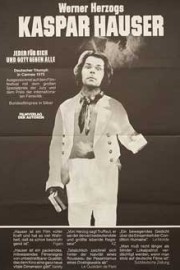The Enigma of Kaspar Hauser
Werner Herzog is one of the most unique filmmakers of all-time. Regardless of whether it’s in the documentary subjects he chooses, or the narrative features he makes, you can always tell when you’re watching a Herzog film. As I’m writing this, Herzog has just appeared in a couple of episodes of Disney+’s “The Mandalorian” as the man whom hires the titular character to retrieve, and deliver, “Baby Yoda.” I’m curious how many people would look at Herzog’s performance in that, which gives us what we expect from Herzog, and seek out more from him. Probably not many, but that distinctive voice, and way of speaking, is all throughout his career as a filmmaker, whether he’s in front of the camera or behind it.
As I was watching Herzog’s “The Enigma of Kaspar Hauser,” I couldn’t help but wonder if David Lynch had seen it prior to directing “The Elephant Man.” Structurally, the films have a lot in common, and both are based on true stories. Of course, Lynch already had a stage play to work off in adapting John Merrick’s story for the screen; Herzog had just the legend and writings around the curious case of Kaspar Hauser, a foundling whom appeared one day, in 1828 Nuremberg, unable to speak or walk. He had been confined to a room his entire life, and the community tries to understand him, to figure out his life. He can only say a handful of words, is very particular about his food, and came with a note with a rudimentary history of who Kaspar is. He eventually finds himself embraced, as much as he can be, by the community, and he starts to be able to express himself, and have a personality of his own, endearing himself to the townspeople.
Kaspar is played by Bruno S, a street performer Herzog also used later in his American immigrant story, “Stroszek,” and one thing is certain with Herzog- he has a wonderful, weird eye for actors he works with in his narrative features. Bruno S is uniquely charismatic, and his face is distinctive and full of personality all on its own, which is especially important given how little, and haltingly, Kaspar speaks in this film. There’s a life to his facial expressions and eyes that is probably what intrigued Herzog so much; Klaus Kinski was the same way, but he conveys different things. Kinski represented madness and chaos, and Bruno represents sadness and a painful solemnity. We watch “Kaspar Hauser,” and there’s something haunting about the way Herzog and Bruno tell this story, but also so filled with life and entertainment. The film is supposedly pretty accurate to Hauser’s life- although he was left as a teenage boy, and Bruno S. is very definitely a grown man, but having Bruno play the character all the way through, and seemingly aging him up, makes the story more compelling to watch. For Herzog, I think he’s more interested in how a grown adult, thrust into society for the first time, would react; with a teenager, their cognitive learning is still going on, so adaptation is a bit easier, but for a man, that process would be a bit harder, and seeing Kaspar going through this process of learning to live in Bruno’s performance makes the story just a bit more affecting.
In both “Stroszek” and this film, I’m fascinated by how much these films feel familiar and, dare I say, “safe,” from a narrative standpoint compared to the films he did with Kinski. Maybe he felt like he needed to keep the stories more accessible with Bruno S in the lead; certainly, because of Kinski’s personality and energy, something more dangerous is bound to come out. Bruno S is not like that, and yet, he is as perfect an on-screen foil for Herzog as Kinski was. He represents Herzog’s humanity and humility, the quiet artist whom travels places like the arctic for scenes of beauty and peace or in caves in France to look at civilizations long lost, and “The Enigma of Kaspar Hauser” may be one of his most beautiful attempts at capturing the good, and nurturing, part of life.










